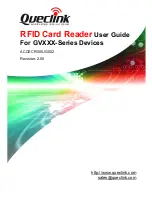
KPCI-3101 — KPCI-3104 Series User’s Manual
Analog output conversion modes
KPCI-3102 and KPCI-3104 boards can perform single value operations only. Use software to
specify the range, gain, and analog output channel (among other parameters), then output the
data from the specified channel. You cannot specify a clock source, trigger source, or buffer.
Single value operations stop automatically when finished; you cannot stop a single value
operation.
Data format
Data from the host computer must use offset binary data encoding for analog output signals.
DriverLINX converts this “native format” to a hardware-independent format so that applications
can use the numeric operations that are intrinsic to most high-level languages. A DriverLINX
Service Request may be used for several types of data conversions (such as VOLTS2CODE con-
version that converts analog voltage to D/A code). Because the data values depend on the
selected gain at the time of the data transfer, you should use DriverLINX to convert the data, as
it takes the gain properties of the Service Request into account.
NOTE
Refer to the DriverLINX Analog I/O Programming Guide, provided with
DriverLINX.
Digital I/O features
This section describes the following features of the digital I/O subsystem:
•
Digital I/O lines
•
Combining or Splitting Logical Channels
•
Using Single Value and Continuous Digital Input
Digital I/O lines
KPCI-3101–4 Series boards support 23 digital I/O lines through the digital input (DIN) and out-
put (DOUT) subsystems; DIN and DOUT subsystems use the same digital I/O lines. These lines
are divided into the following ports:
•
Port A, lines 0 to 7
•
Port B, lines 0 to 7
•
Port C, lines 0 to 6
You can use each port for either input or output; all lines within a port have the same
configuration. For example, if you use Port A as an input port, lines 0 to 7 of Port A are
configured as inputs. Likewise, if you use Port C as an output port, lines 0 to 6 of Port C are
configured as outputs.
DriverLINX lets you dynamically reconfigure digital I/O ports at run time using a “Digital Setup
Event.” Refer to DriverLINX Digital I/O Programming Guide for information and limitations of
this function.
For fast, clocked digital input operations, you can enter the digital I/O lines from Ports A and B
as a channel in the analog input channel list; refer to
for more information.
By default, the digital I/O lines power up as digital inputs. On power up or reset, no digital data
is output from the board.
Summary of Contents for KPCI-3101 Series
Page 10: ...iv...
Page 15: ...1 Overview...
Page 21: ...2 Principles of Operation...
Page 53: ...3 Installation and Configuration...
Page 78: ...3 26 Installation and Configuration KPCI 3101 KPCI 3104 Series User s Manual...
Page 79: ...4 Testing the Board...
Page 82: ...4 4 Testing the Board KPCI 3101 KPCI 3104 Series User s Manual...
Page 83: ...5 Calibration...
Page 86: ...5 4 Calibration KPCI 3101 KPCI 3104 Series User s Manual...
Page 87: ...6 Troubleshooting...
Page 94: ...6 8 Troubleshooting KPCI 3101 KPCI 3104 Series User s Manual...
Page 95: ...A Specifications...
Page 107: ...B Connector Pin Assignments...
Page 111: ...C Systematic Problem Isolation...
Page 145: ...This page intentionally left blank...
Page 146: ...Keithley Instruments Inc 28775 Aurora Road Cleveland Ohio 44139 Printed in the U S A...
















































